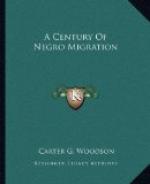This unusual problem in spite of additional effort, however, would not readily admit of solution. Benevolent workers of the North, therefore, began to minister to the needs of these unfortunate blacks. They sent considerable sums of money, increasing quantities of clothing and even some of their most devoted men and women to toil among them as social workers and teachers.[29] These efforts also took organized form in various parts of the North under the direction of The Pennsylvania Freedmen’s Relief Association, The Tract Society, The American Missionary Association, Pennsylvania Friends Freedmen’s Relief Association, Old School Presbyterian Mission, The Reformed Presbyterian Mission, The New England Freedmen’s Aid Committee, The New England Freedmen’s Aid Society, The New England Freedmen’s Mission, The Washington Christian Union, The Universalists of Maine, The New York Freedmen’s Relief Association, The Hartford Relief Society, The National Freedmen’s Relief Association of the District of Columbia, and finally the Freedmen’s Bureau.[30]
As an outlet to the congested grouping of Negroes and poor whites in the war camps it was arranged to send a number of them to the loyal States as fast as there presented themselves opportunities for finding homes and employment. Cairo, Illinois, in the West, became the center of such activities extending its ramifications into all parts of the invaded southern territory. Some of the refugees permanently settled in the North, taking up the work abandoned by the northern soldiers who went to war.[31] It was soon found necessary to appoint a superintendent of such affairs at Cairo, for there were those who, desiring to lead a straggling life, had to be restrained from crime by military surveillance and regulations requiring labor for self-support. Exactly how many whites and blacks were thus aided to reach northern communities cannot be determined but in view of the frequent mention of their movements by travellers the number must have been considerable. In some cases, as in Lawrence, Kansas, there were assembled enough freedmen to constitute a distinct group.[32] Speaking of this settlement the editor of the Alton Telegraph said in 1862 that although they amounted to many hundreds not one, that he could learn of, had been a public charge. They readily found employment at fair wages, and soon made themselves comfortable.[33]
There was a little apprehension that the North would be overrun by such blacks. Some had no such fear, however, for the reason that the census did not indicate such a movement. Many slaves were freed in the North prior to 1860, yet with all the emigration from the slave States to the North there were then in all the Northern States but 226,152 free blacks, while there were in the slave States 261,918, an excess of 35,766 in the slave States. Frederick Starr believed that during the Civil War there might be an influx for a few months but it would not continue.[34] They would return when sure that they would be free. Starr thought that, if necessary, these refugees might be used in building the much desired Pacific Railroad to divert them from the North.




